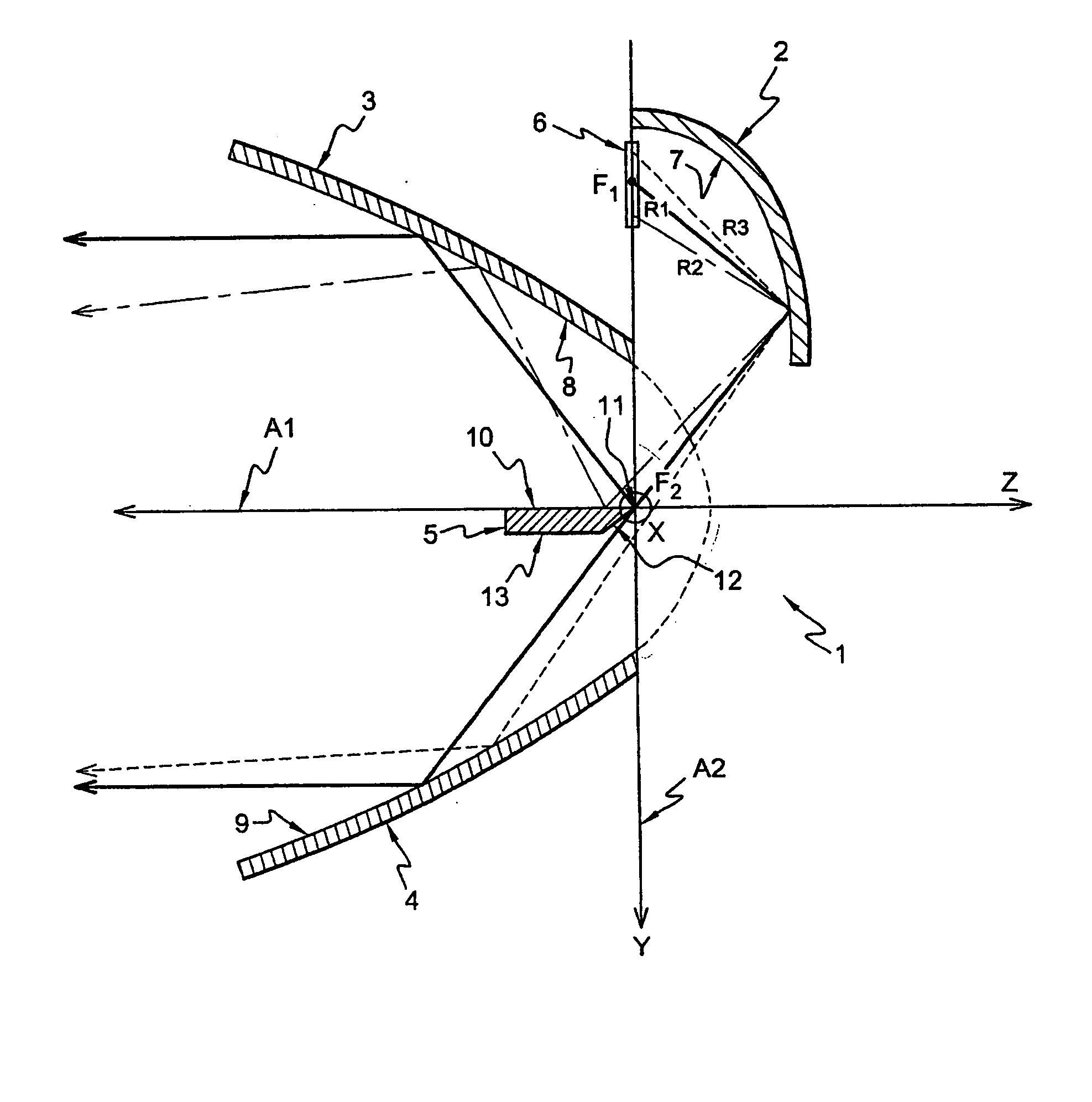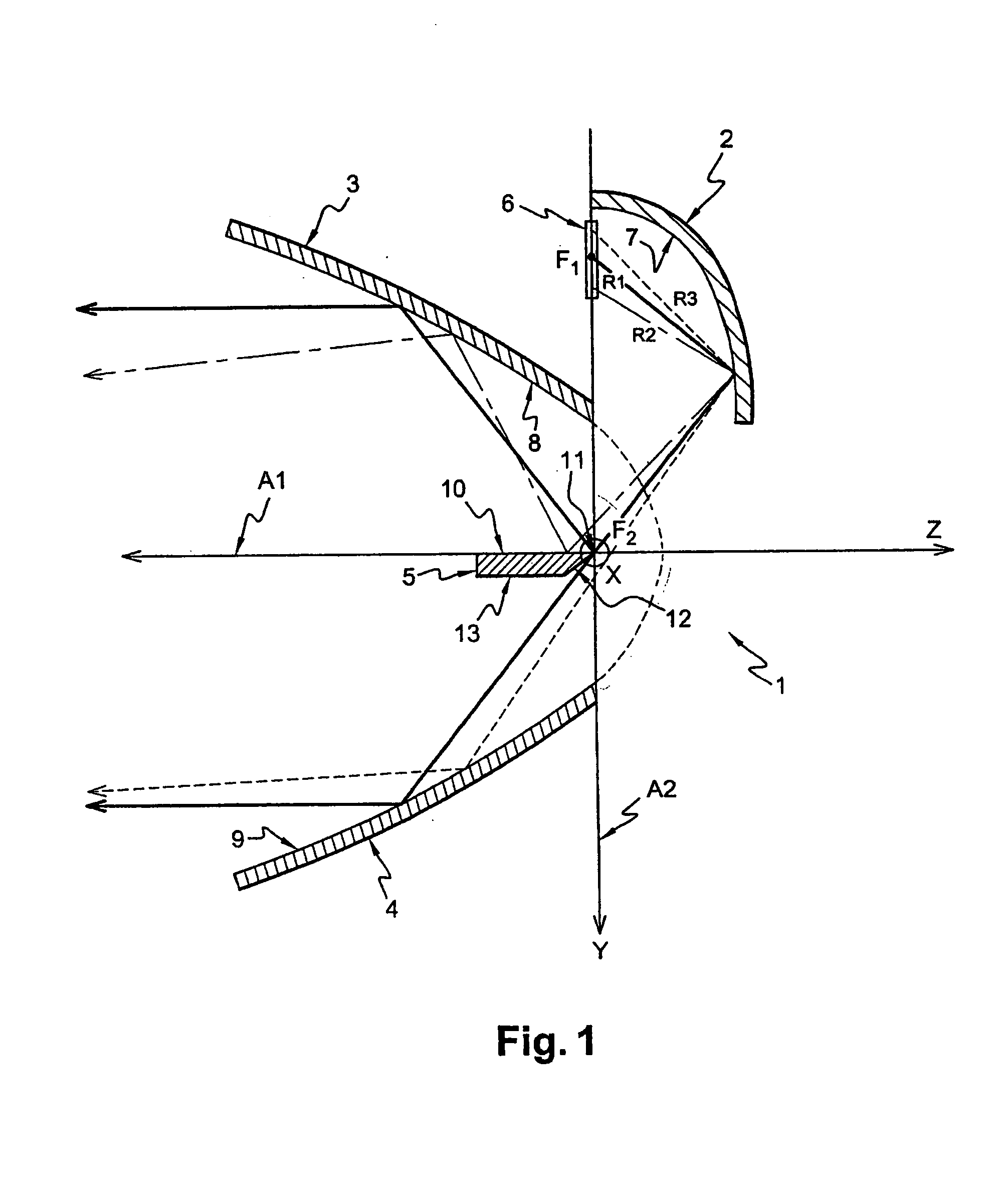Lighting module for a vehicle headlight
a technology for vehicle headlights and light modules, which is applied in the direction of fixed installation, lighting and heating equipment, lighting support devices, etc., can solve the problems of difficult to produce a clean cut-off, significant part of the light flux emitted by the light source is dissipated in the rear face of the mask, and achieves the elimination of the use of masks, reducing the amount of light flux lost, and ensuring the effect of safety
- Summary
- Abstract
- Description
- Claims
- Application Information
AI Technical Summary
Benefits of technology
Problems solved by technology
Method used
Image
Examples
first embodiment
[0071]FIG. 1 shows diagrammatically a side view of a lighting module 1 for a vehicle headlight in the invention.
[0072] The module 1 comprises a first reflector 2, a second reflector 3, a third reflector 4, a fourth reflector 5, and a light source 6.
[0073] The second reflector 3 is an elliptical reflector having two foci F1 and F2, an optical axis A2, and a substantially elliptical reflective surface 7.
[0074] The substantially elliptical reflective surface 7 is made in the form of an angular sector of what is substantially a body of revolution, and lies in the half space which is situated above an axial plane at right angles to the plane of the page, this plane containing the optical axis A2. In a first approximation, the surface 7 is semi-elliptical.
[0075] However, it may be noted that the surface 7 may not be perfectly elliptical, and may have a plurality of specific profiles which are arranged to optimise the distribution of light in the light beam which is produced by the modu...
second embodiment
[0096]FIG. 2 shows diagrammatically a side view of a lighting module 100 for a vehicle headlight, in the invention.
[0097] The module 100 is identical to the module 1 in FIG. 1, except that it also includes a fifth reflector 14.
[0098] This fifth reflector has a reflective surface 15 which receives light rays directly from the light source 6 and produces a beam of light rays below the horizontal cut-off line. If the light source 6 were a point source and not surrounded by any optical apparatus, the reflective surface 15 would be a parabolic surface with a focus situated at the second focus F2 of the first reflector.
[0099] In practice, the light source 6, such as a light emitting diode, is not a point source, and it includes a chip, not shown, with a square or rectangular surface surrounded by a spherical half lens of plastics material, also not shown, which is centred on the centre of the chip. As a result, the non-point characteristics of the source and lens must be taken into cons...
third embodiment
[0107]FIG. 3 shows diagrammatically a side view of a lighting module 101 for a vehicle headlight, in the invention.
[0108] The module 101 is identical to the module 1 in FIG. 1, except that it further includes a reflector 18 referred to as a reflector without cut-off, and a second light source 20.
[0109] The reflector 18 without cut-off has an internal reflective surface 19 which is substantially parabolic, an optical axis coincident with the optical axis A1 of the second and third reflectors 3 and 4, and a focus F3.
[0110] The focus F3 is positioned positively on the axis F2-Z, and the light source 20 is arranged in the vicinity of the said focus F3.
[0111] If the reflective surface 19 of the reflector 18 without cut-off were a true parabola, it would produce a substantially circular output beam without any cut-off. Now, the regulating authorities require that functions not having any cut-off, of the main beam or DRL type, should have a beam which is about twice as wide as it is hig...
PUM
 Login to View More
Login to View More Abstract
Description
Claims
Application Information
 Login to View More
Login to View More - R&D
- Intellectual Property
- Life Sciences
- Materials
- Tech Scout
- Unparalleled Data Quality
- Higher Quality Content
- 60% Fewer Hallucinations
Browse by: Latest US Patents, China's latest patents, Technical Efficacy Thesaurus, Application Domain, Technology Topic, Popular Technical Reports.
© 2025 PatSnap. All rights reserved.Legal|Privacy policy|Modern Slavery Act Transparency Statement|Sitemap|About US| Contact US: help@patsnap.com



